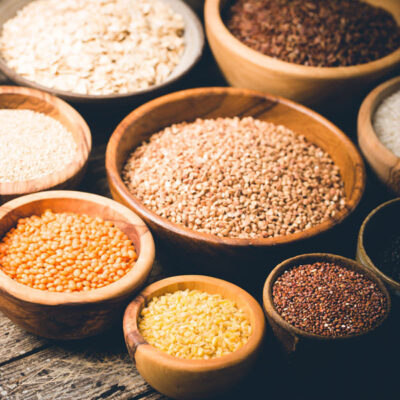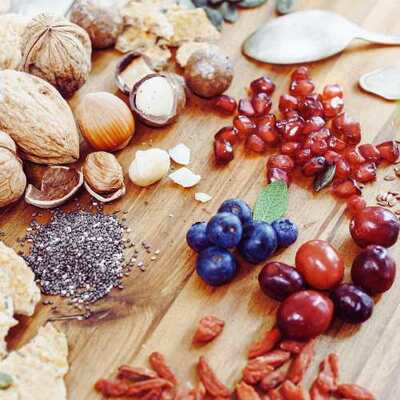Making The Most of Rice Flour in Your Gluten-Free Kitchen
Author: admin Date Posted:24 May 2024

Gluten Free Baking? Rice flour, a staple in the gluten-free pantry, is a game-changer for everything from fluffy pancakes to crispy tempura, all without gluten.
Rice flour, often a staple in gluten-free pantries, can be a game-changer for those looking to whip up everything from fluffy pancakes to crispy tempura, all without a speck of gluten. So, whether you're celiac, gluten-sensitive, or just cutting back on wheat for personal preference, let's explore some of the ways you can make the most of rice flour in your kitchen too.
What is Rice Flour?
Rice flour is the product of finely milling rice grains to form a flour. It is made from either white or brown rice and has been used for centuries in traditional cuisines, especially in Asian cultures. It should contain nothing other than 100% rice, but it is always worth checking the label to be absolutely sure.
What's the difference between white and brown rice flour?
The key difference between white and brown rice flour lies in the type of rice they're milled from.
White rice flour comes from refined white rice, which has had its bran and germ removed. This process gives it a lighter texture and a milder taste, making it a fantastic thickener for sauces or a sleek base for light cake recipes. Like white rice, it has a sweet, somewhat neutral flavour.
Brown rice flour is made from the entire kernel so it has more nutrients, as well as a richer, nuttier flavour. Added to breads and baked goods, it has a heavier, more textured, wholesome feel.
Is Rice Flour Gluten Free?
Yes, made from 100% rice, both brown and rice flour are gluten-free.
Can I Use Rice Flour Instead of Gluten Free Flour?
Rice flour is made from a single grain, whilst commercial gluten-free flour is made from a blend of more than one ingredient. It is produced that way in order to create an all purpose product with a variety of uses as it is very difficult to mimic the unique properties of wheat flour. The aim is to strike the right balance of starch and protein. You can find out more about this in our article 'an in-depth guide to using gluten free flours'.
Neither wholly starch, or particularly high in protein, the neutral, somewhat sweet, flavour of white rice flour makes it an ideal component of all-purpose gluten-free flour blends, which you can buy off the shelf, or make up yourself.
Used alone, rice flour does have its limitations and will not always be suitable for every purpose, but there are times when it is the perfect flour for the job.
What is Rice Flour Used For?
Rice flour is incredibly versatile and can be used in a number of ways. Here are just a few:
Baking
Rice flour can be an excellent option for gluten-free baking. It's often used in cakes, cookies, and muffins to provide a delicate, fine crumb.
Thickening Agent
Its neutral flavour makes rice flour a go-to for thickening soups, sauces, and gravies without altering the taste.
Noodles
In many Asian cuisines, rice flour is the base for making tender and chewy noodles.
Deep Frying
It's a popular choice for creating a light, crispy batter for fried foods or as a dusting for meats and veggies before sautéing.
Flatbreads
As a staple grain in many parts of the world, rice flour is used for making flatbreads, offering a wheat-free alternative with great texture.
Desserts
It’s a star in sweet dishes too, particularly in making mochi or other traditional sweets.
Advantages of rice flour
One of the standout advantages of rice flour is its relative versatility in the kitchen. Whether you're whipping up a batch of crispy tempura, crafting delicate noodles, or baking a light and fluffy sponge cake, rice flour can rise to the occasion.
A useful store cupboard staple for those with dietary restrictions, ensuring that everyone can indulge in their favourite treats, rice flour has a light texture makes it an excellent choice for recipes that require a subtle finish without overpowering other ingredients.
Disadvantages of rice flour
To be fair, rice flour is not without its drawbacks. While it's a fantastic gluten-free option, it can sometimes result in a crumbly or gritty texture, particularly in baked goods that crave the stretchiness of gluten. It also tends to absorb more moisture than wheat flour, which can be a bit of a balancing act when tweaking traditional recipes.
Rice flour on its own lacks some of the nutritional benefits found in its gluten-containing counterparts and doesn't provide the same rise and elasticity that many baked recipes depend on. So while it is incredibly versatile, it may require a bit of experimentation and patience to perfect its use.
When it comes to using gluten free flour, and rice flour is no exception, it is essential to understand how your chosen ingredient behaves and to use it wisely. By all means experiment to see how far you can push the boundaries, but achieving perfect results in gluten-free cooking is always a fine balancing act.
Using Rice Flour as a Thickener
Rice flour is excellent for thickening sauces and gravies, adding more body than cornflour or other similar starches. Just go slowly though as it takes longer to thicken than starch or wheat flour so it can be easy to add too much.
Using Rice Flour in Baking
There are times in baking when the gluten in wheat flour is not really needed or can actually work against you. Think about the tender crumb of a delicate sponge cake that can so easily become tough when overmixed. Or the crisp crust of a cookie or a pastry that requires the lightest of touches lest the gluten be overstretched. A chewy gooey brownie requires very little flour to begin with, so switching to rice flour is barely even noticed. Sometimes the dreaded sandy texture of rice flour can even work in your favour. Shortbread, anyone?
How to make a basic rice flour mixture for baking
For best results when baking with gluten free flours you should consider adapting each recipe individually, switching out individual flours to achieve the best result possible. But there are times when you can use an all purpose blend that you can store in the cupboard in the same way as you would all purpose wheat flour.
Creating your own basic rice flour mixture for baking is simple. Start with 2 cups of finely ground rice flour. Then, for every cup of rice flour, add 2/3 cup of potato starch and 1/3 cup of tapioca starch to help give it the structure it might miss without gluten. A pinch of xanthan gum (about 1 teaspoon for this mix) can also help mimic gluten’s elastic qualities.
When it comes to substituting gluten-free flour for wheat flour, it's not always a straight one-to-one swap. Gluten-free flours have different textural properties and densities, and they often require a bit of trial and error to get the proportions just right for your recipe.
Adjusting recipes to substitute wheat flour with rice flour
Let's talk about tweaking those recipes when substituting wheat flour with our rice flour blend.
First off, you need to know that rice flour is thirsty; it soaks up moisture like a sponge. So, you might need to add a little more liquid to stop your dough from being too crumbly. And since rice flour is also lighter than wheat flour, your bakes might need a little extra help to rise, so consider increasing your leavening agents slightly. Still, there's nothing daunting about it! Just start slow, perhaps with a 1:1 swap, and then adjust from there. Keep notes of what works (and what doesn't) until you get results you are happy with.
How to prevent grittiness with rice flour
Fortunately grittiness is not as tricky to tackle as you might think.
- To steer clear of that sandy texture, a good rule of thumb is to use a finely ground rice flour. The finer the grind, the smoother your baked goods will feel.
- Hydrate your rice flour by letting your batter or dough rest for about 30 minutes before baking. This gives the flour time to absorb the liquids fully, resulting in a finer, tender crumb.
- Don't skip sifting; it aerates your flour, helping to keep things light and fluffy.
Using Rice Flour for Deep Frying
Rice flour makes an ideal batter for deep frying and is the quickest route to that all important crispy crunchy crust.
The light and fine texture of rice flour helps create an irresistibly crispy coating that turns golden brown and holds up better to sauces and dips without getting soggy. And this is one time where the crunchy, gritty texture can work in your favour. Here's a tip: mixing rice flour with a bit of cornstarch can work wonders for an even crunchier, more durable crust.
It's a gluten-free godsend for those who still want to enjoy perfectly fried chicken, crispy onion rings, or a batch of tempura veggies without the gluten.
Recipe for crispy rice flour batter
Ingredients:
- 1 cup rice flour
- 2 tablespoons cornstarch
- 1 teaspoon baking powder
- 1/2 teaspoon salt
- 1/4 teaspoon pepper (or to taste)
- 1 cup cold sparkling water (for extra lightness!)
- Optional seasoning: pinch of paprika or garlic powder to enhance the flavour
Instructions:
- In a large bowl, whisk together the rice flour, cornstarch, baking powder, salt, and pepper.
- Slowly pour in the cold sparkling water, and stir until just combined.
- Let your batter sit for about 10 minutes. This allows any lumps to smooth out and gives the rice flour time to hydrate so it is tender.
And there you have it, it looks like rice flour could be a vital ingredient in your gluten-free kitchen.
Its light texture and neutrality mean it's your perfect partner for a range of recipes, from thickening sauces to baking brownies and beyond. All in all we think its a great kitchen staple.
Where to buy rice flour in bulk
There are many ways to save the pennies here at Opera Foods. Take advantage of bulk buy savings on our organic white rice flour, or register for a wholesale account for even greater discounts.



